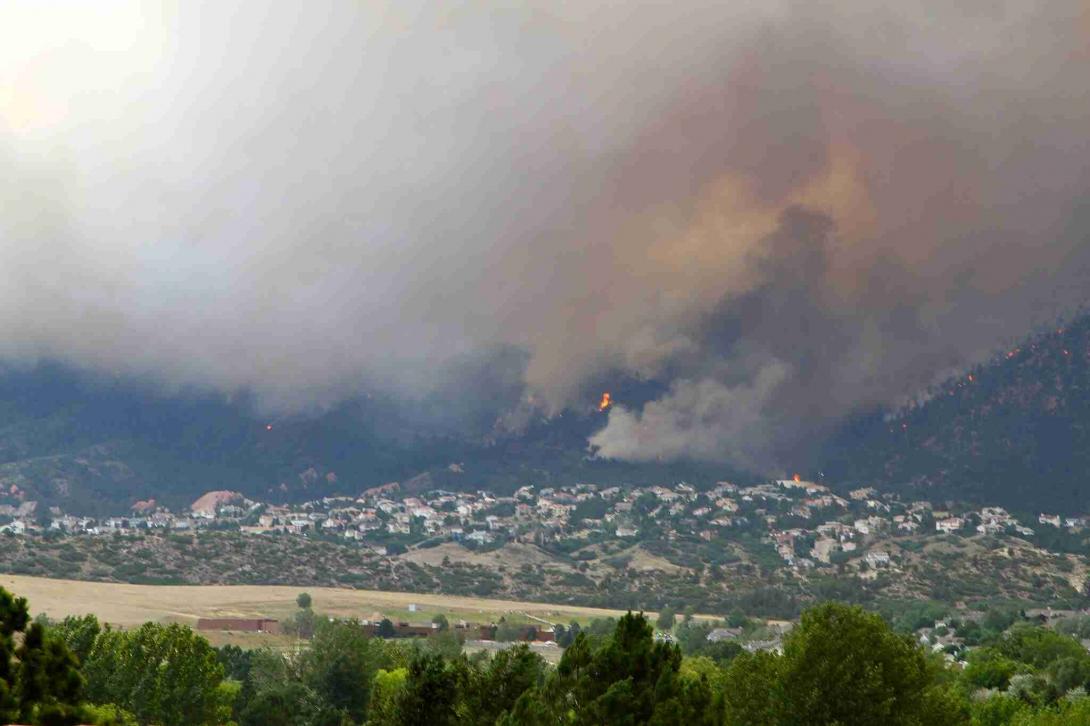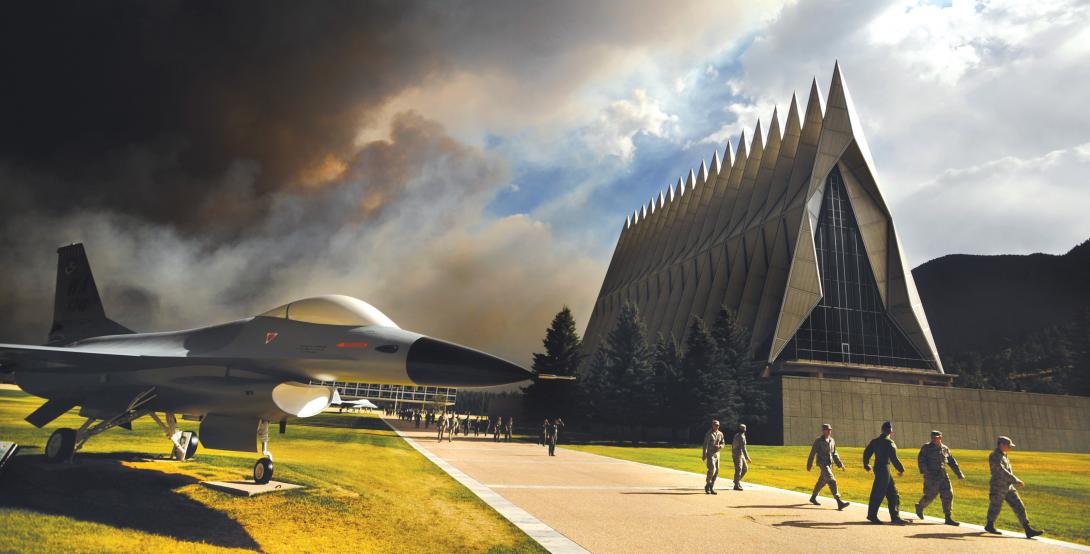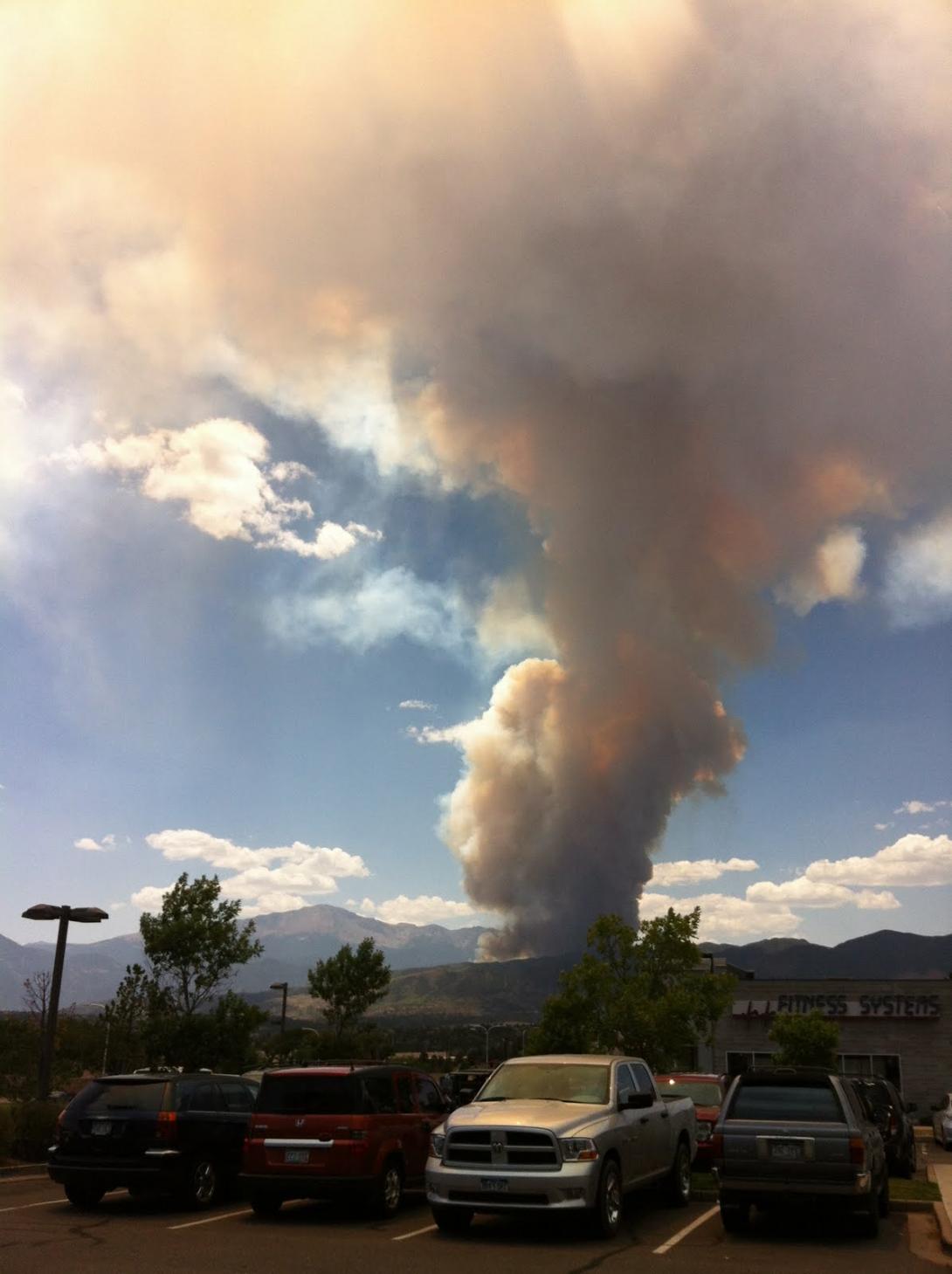Waldo Canyon Fire
Full Article
On June 22, 2012, the Waldo Canyon Fire ignited northwest of Colorado Springs, perilously close to neighborhoods and businesses in one of the most populated areas on Colorado’s Front Range. Although local and federal agencies immediately converged on the blaze, hot, dry, and windy conditions quickly pushed the flames east into the city, with catastrophic results. By the time the fire was fully contained on July 10, two people had died and 346 houses burned, even though the fired covered a relatively small area of 18,247 acres.
The property damage and loss of life made the Waldo Canyon Fire the most destructive in Colorado history at that point, until it was surpassed the following year by the nearby Black Forest Fire, which burned more than 500 houses. The cause of the Waldo Canyon Fire was determined to be human activity, but investigators did not identify what exactly sparked it. On top of the destruction, allegations of mismanagement plagued city leaders in the fire’s aftermath, making the fire as controversial as it was destructive.
Origins
By late June 2012, Colorado’s Front Range was experiencing unseasonably hot and dry weather after a winter of below-average snowfall. By the time the Waldo Canyon Fire started on June 22, the High Park Fire in Larimer County had killed one person and burned nearly 80,000 acres, while the Woodland Heights Fire threatened Rocky Mountain National Park. Across the state, several other fires burned simultaneously, from Leadville to Grand Junction to Mancos in Montezuma County.
On June 22, the El Paso County Sheriff’s office received reports of smoke in the area of the Waldo Canyon Trailhead, just off US Highway 24 northwest of Colorado Springs. The fire was located the next day. The US Forest Service took control of firefighting operations, which included local and federal agencies. Bulldozers dug out fire breaks on June 23 to protect several nearby neighborhoods, which received voluntary evacuation notices that switched to mandatory evacuation orders later in the day. The Colorado Springs Fire Department established a base of operations at a Safeway store on West Colorado Avenue, an indication of how close the fire was to the city.
On June 24, a full evacuation order was issued for the town of Manitou Springs, a popular tourist haven five miles northwest of Colorado Springs, and the Colorado State Patrol closed Highway 24. A local Red Cross chapter set up shelters for evacuees at Cheyenne Mountain High School and Woodland Park High School.
Community Devastation
June 26 proved to be the deadliest day of the Waldo Canyon Fire. A Red Flag warning (for high winds) was issued for the area that morning, and gusts up to ninety-four miles per hour were reported at the US Air Force Academy. Fueled by incessant wind, the blaze crossed a ridge and rapidly descended into the Mountain Shadows subdivision, where it burned hundreds of houses. Later investigations showed that an evacuation plan for the neighborhood was hastily put in place that morning, which resulted in many residents not knowing they had to leave until it was too late. Two Mountain Shadows residents, William and Barbara Everett, died in their burning house as they tried to leave. Many others barely escaped.
With the assistance of law enforcement from across the region, additional evacuations took place that day south of the Air Force Academy and west of Interstate 25. Meanwhile, crews worked to protect and remove flammables from the historic Glen Eyrie property, which survived the blaze. Another Red Flag warning was issued the following day, but winds subsided on June 28, slowing the fire somewhat.
On June 29, President Barack Obama arrived in Colorado Springs, accompanied by Representative Doug Lamborn and Colorado senators Mark Udall and Michael Bennet. The president declared a National Emergency in Colorado, mentioning the “enormous devastation” he had seen in Mountain Shadows. Obama praised the “outstanding coordination” of response agencies and noted they were “starting to see progress” on containment.
Thanks to that progress, many evacuees were able to return home that day. Some residents, including those in the town of Green Mountain Falls, came back to find their streets littered with trash, as bears and raccoons—likely fleeing the fire themselves—ransacked the abandoned community (a local marshal oversaw efforts to remove the bears).
As the forecast turned over the next several days, flooding became an additional threat due to the burned-out landscape. On June 30, a flash flood caused a mudslide that damaged Ute Pass Elementary School in Cascade. The damage and threat of future flooding remained long after the Waldo Canyon Fire was finally contained on July 10.
Aftermath
At 18,247 acres, the Waldo Canyon Fire was dwarfed by other fires in terms of size, but its quick spread into Colorado Springs neighborhoods made it the costliest fire in state history to that point. Insurance claims totaled $352.6 million, nearly three times that of the much larger High Park Fire in the same month. More than 340 houses were destroyed, all of them in Mountain Shadows.
On April 3, 2013, the city of Colorado Springs released its Final After Action Report on the fire, which detailed several areas for improvement in fire response. In addition to improving real-time communication and deployment of staff and volunteers, the report recommended better implementation of the Incident Command System (ICS), a standardized system for coordinated emergency response developed after disastrous wildfires in California during the 1960s and 1970s. Bill Gabbert, a former firefighter who battled wildfire in 1970s California, opined that “roughly 75 percent of the problems identified” in official reports “could have been avoided if Colorado Springs had fully implemented the ICS.” To Gabbert, it was “difficult to understand” why Colorado Springs, with so much development in “a wildfire-prone area,” had not fully implemented the ICS by 2012.
In addition to its apparent lack of preparedness, the city’s response to the fire’s surge into Mountain Shadows was also criticized. Even though they had been warned of the potential for erratic fire behavior on June 26, local fire crews concentrated resources on what they believed was the fire’s most likely path—south into the Cedar Heights community—leaving few resources to defend Mountain Shadows. Moreover, the city failed to issue evacuations for the community when the fire entered Queens Canyon, a previously agreed-upon trigger point for evacuations in Mountain Shadows. Some residents believed these decisions directly led to the loss of life and property.
Following the fire, Colorado Springs mayor Steve Bach established Colorado Springs Together, a nonprofit intended to help fire victims get the resources they needed to rebuild. From 2012 to 2014, the group received more than $500,000 in donations, the bulk of which were spent on a new park in Mountain Shadows and a memorial for the fire and its victims.
In addition, the El Pomar Foundation and Pikes Peak United Way formed the Waldo Canyon Fire Assistance Fund, which raised more than $940,000 for local nonprofits involved in recovery and cleanup.
Legacy
Fire damage in the Pike National Forest northwest of Colorado Springs was so extensive that the area remained closed to the public until 2017. That year, the city established June 26 as Waldo Canyon Fire Commemoration Day.
The following year, as hundreds of new houses were completed in Mountain Shadows, a coalition of local and federal agencies led by the Rocky Mountain Field Institute received a grant from Colorado Parks and Wildlife to launch Re-Imagine Waldo Canyon, a community-centric group that would come up with a plan for the burned area. In June 2020, the group published its final report outlining its plans for rebuilding a trail network, protecting wildlife, and restoring drainages and other important natural features in the burned area.
Along with the other fires that burned near communities in 2012, the Waldo Canyon Fire served as a poignant and tragic reminder of the inherent dangers of the Wildland-Urban Interface—a term that describes urban and suburban sprawl into fire-prone mountain areas across the country. It also remains part of a large post-2000 fire portfolio that, in sum, points to the increased potential for devastating wildfires in an American West wracked by climate change.

























